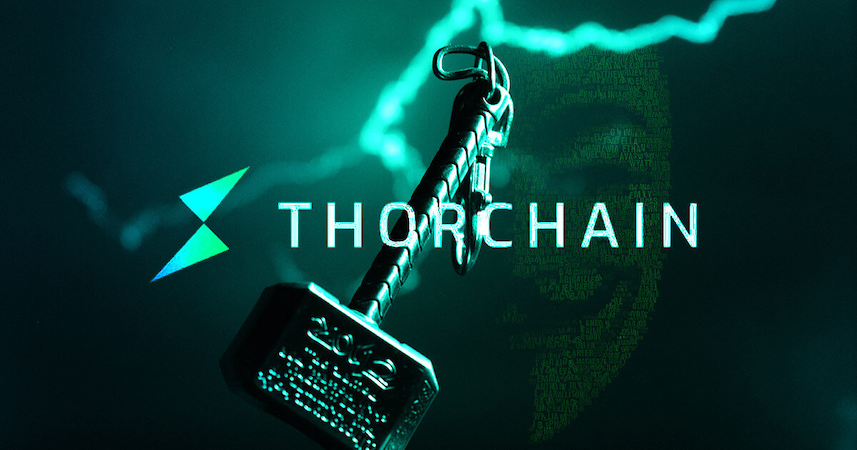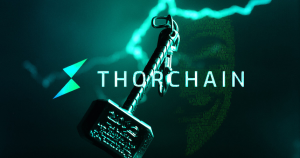Join Our Telegram channel to stay up to date on breaking news coverage
THORChain has been in the news lately and its native token RUNE has experienced a significant rally over the last week of over 17%, which is significant during a time when alt prices have been stagnant, with Bitcoin continuing to hover around the $28,000 mark.
The resulting rise could be attributed to Guy Turner, the host of the very popular YouTube channel Coin Bureau, and his recent video in which he mentioned ThorChain as one of the most promising projects that he’s keeping an eye on and is optimistic about.
What is ThorChain?
Native Assets
Anyone can use THORChain to swap native assets between any supported chains. What is unique about it is that it doesn’t involve synthetic assets, or “wrapped tokens” as they are sometimes called, such as wBTC, wETH, etc. Almost all other existing solutions to this problem of swapping between different chains have the major weakness that they rely on wrapped tokens.
Using wrapped assets breaks decentralization, as these are usually issued and held by centralized exchanges and, in addition, exposes the user to many security issues. For example, when popular exchange FTX went out of business, users that relied on wrapped assets issued by the exchange lost it all.
THORChain is a non-profit organization and its team doesn’t keep any of the RUNE funds used for fees on the protocol but instead distributes all RUNE spent on fees to network participants.
Non-Custodial
On THORChain’s native RUNE token, Guy said that it has a real utility mentioned that
Over half of RUNE’s supply is not in circulation.
He is optimistic about the project because it is one of the only ones to provide swapping of this kind, without the use of wrapped tokens, and because of its open source nature, which makes it open and easier to check for vulnerabilities by anyone.
As risk factors, Guy mentions the U.S. regulatory environment and their future actions. He believes THORChain has a real chance of taking off and become a major player in the crypto ecosystem, but only if U.S. regulation will be favorable to it.
Price potential
Guy also correctly states that RUNE’s price has declined by over 90% from its peak at the top of the crypto bull market. Indeed, in May 2021 RUNE reached a high of over $21, and it then went down all the way to around $1. This correction, Guy believes (and we agree), is not a sign of weakness with regards to the project itself, but rather a natural consequence of the decline of the entire crypto market, which was led by the decline of Bitcoin.
As we know, cryptocurrencies is cyclical in nature, corresponding to periods around Bitcoin’s halving, and it experiences major bull cycles, lasting several years, during which the values become overinflated, followed by major declines that bring prices way under the actual values, to oversold territory.
THORChain’s RUNE, therefore, has very likely followed a similar path, and there are high chances it will rise again during crypto’s next bull cycle, to take over the previous high and probably go up much further. Other alt coins such as ADA, have all followed similar bust and booms cycles during their coin lifetimes.
The recent rise in RUNE
Whether the recent rise was due to Guy’s video cannot be ascertained, although it seemed to follow the week after the video was released and he is a well respected voice in the crypto community, with over 2.25 million subscribers.
What’s certain is that the price rallied from a low of $1.397 on April 2 to a high of $1.662 on April 5, which is a spectacular 18.8% increase, at a time when the alt market has been generally stagnant. Since then, there has been a pullback to $1.54, but that looks like a temporary correction in an uptrend that has become established.
It wouldn’t be surprising if RUNE continues its upward descent past $2 and above from here, though the exact timing depends heavily on the larger crypto market, as is the case with most tokens.
Earning money on THORChain
Now onto everyone’s favorite part, which is how one can earn rewards by participating in the network.
There are several ways one can generate income by being a participating in the THORChain network. One could run a Node and get rewarded for participating directly in the network. However, this is an option reserved for those with a high technical skill and the necessary hardware, in addition to having a high requirement in terms of RUNE tokens needed.
Luckily, there are several other options that allows almost anyone to participate in the network and earn yield.
Liquidity Providers
According to THORChain’s official documentation,
Liquidity providers provide assets to the THORChain liquidity pools. They are compensated with swap fees and system rewards. Compensation is affected by a number of factors related to the pool and the state of the network.
Similar to other networks, to be a Liquidity Provider (LP), a user needs to deposit assets in a Liquidity Pool and they will then earn yield in return. The users will earn tokens in Rune and the pool’s connected asset. For example, someone who has deposited in the BTC/RUNE pool will receive rewards in BTC and RUNE.
So, essentially, the LPs lend their assets to the network, and get rewarded a percentage of the swap fee whenever trades execute trades.
The main benefit for Liquidity Providers is that they’re able to earn yields on stagnant assets like Bitcoin, Binance Coin and so on, which hasn’t been possible before. You can visit the Rebase’s explanatory documentation on Providing Liquidity to find out more.
Arbitrageurs
Arbitrage is profiting from price differences across different exchanges. Contrary to other networks where arbitrage is discourage, arbitrageurs actually play an essential part in the THORChain ecosystem. Their role is to keep the Liquidity Pools in balance in the right ratio, which is determined by the network. Thus, if swaps cause a Liquidity Pool to get out of balance, it will cause the price of assets to become lower (or higher) than on other exchanges.
Arbitrage on THORChain is public and available to anyone. Currently arb is very profitable for those who are engaging since there is still not much competition. This should increase over time, pushing profits back to pools.
Tools such as https://t.co/toiPwdbGd8 can help.
— THORChain (@THORChain) November 4, 2020
Arbitrageurs that monitor that particular pool will then be able to buy an asset from the outside exchange and sell it on THORChain (in case the asset is priced lower outside) or, conversely, to buy it from THORChain and sell it on the outside exchange (in case the asset is priced higher inside the LP), for a profit.
This action provides liquidity to the system and ensures the LPs are brought back to their needed ratios, and thus arbitrage is a needed, useful part for the THORChain network, and provides rewards for the ones doing the arbitrage.
The concepts of THORChain’s continuous Liqudity Pools and arbitrage are explained in great detail on the project’s official documentation.
Savers Vaults
This is the latest innovation from THORChain and allows users to earn yield without any exposure to other assets. In particular, for this yield option, no exposure is needed to RUNE, the network’s asset. In their own words,
At a time when many centralized options have come under stress, THORChain now offers a permission-less, open-source, decentralized self-custody solution that enables users to earn in-kind yield on native assets without any price exposure to RUNE. Thus, a user can use their self-custody wallet to earn Bitcoin on their Bitcoin.
They go on to explain how Savers Vaults work, a feature previously available only on centralized finance (CeFi).
Savers Vaults are a new way to supply single-asset liquidity on THORChain. Any user can simply deposit native Bitcoin, earn in-kind yield, and withdraw their principal any time since they maintain full control of their keys.
The yield is generated from swap fees and block rewards from Liquidity Pools. These fees are being paid to Liquidity Providers (LPs) whenever users swap using the network. Savers earn about half the yield of a typical RUNE-ASSET LP would earn in the same period, but without the inherent risk of having to hold the RUNE token.
In conclusion, it is very profitable to participate in the network, compared to other decentralized platforms. Early participants have seen returns as LPs 10 times more than on Uniswap, with a low-risk of impermanent loss due to the slip-based fees and network rewards.
Security Vulnerability Addressed
On March 28, THORChain Foundation made an announcement that it had discovered a potential vulnerability in its network, and suspended trading on the platform temporarily to conduct an investigation. At that time, the token went down around 5%, though it has since fully recovered.
While this event could be construed as a negative, the fact that the vulnerability did not lead to any loss of investors’ funds and that it was detected and addressed is, in fact, a great positive for the network. It means it pro-actively monitors security issues and is quick to act on vulnerabilities when they are detected.
Network preemptively paused by NO's to investigate the report; updates will follow. https://t.co/xHopP9Aufp
— Nine Realms (@ninerealms_cap) March 28, 2023
We should also bear in mind that THORChain is one of the few projects that is employing its own in-house dedicated security teams as Chad Barraford, its founder, mentioned. While most projects rely on third-party auditors, it is often the case that even the auditors are not able to find the vulnerabilities since they are unfamiliar with the code base. Particularly for a large code base, having people who are intimately knowledgeable of it can make a huge difference in controlling security and risk.
A very valuable resource to learn more about THORChain, other than the official documentation, is also available on Coin Bureau’s site, and explains using non-technical jargon all the essential concepts involved in how the project functions.
Related
- THORChain Price Prediction: RUNE Bulls Eye A 21% Increase To $2.29
- THORChain: Official Project’s Site
- THORChain (RUNE) Review: Interoperable Liquidity Protocol
Join Our Telegram channel to stay up to date on breaking news coverage



